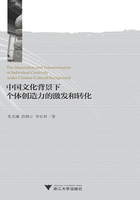
参考文献
[1]Amabile, T.M.(1988).A model of creativity and innovation in organizations.In B.M.Staw& L.L.Cummings(Eds.), Research in organizational behavior(pp.123-167).Greenwich, CT:JAI Press.
[2]Amabile, T.M.(1993).Motivational synergy:toward new conceptualizations of intrinsic and extrinsic motivation in the workplace.Human Resource Management Review,3(3):185-201.
[3]Amabile, T.M., Barsade, S.G., Mueller, J.S., & Staw, B.M.(2005).Affect and creativity at work.Administrative Science Quarterly,50(3):367-403.
[4]Amabile, T.M., & Conti, H.(1999).Changes in the work environment for creativity during downsizing.Academy of Management Journal,42(6):630-640.
[5]Amabile, T.M., Conti, R., Coon, H., Lazenby, J., & Herron, M.(1996).Assessing the work environment for creativity.Academy of Management Journal,39(5):1154-1184.
[6]Amabile, T.M., & Gryskiewicz, N.D.(1987).Creativity in the R&D laboratory. Technical Report No.30.Centre for Creative Leadership, Greensboro, NC.
[7]Amabile, T.M., & Gryskiewicz, N.D.(1989).The creative environment scales:Work environment inventory.Creativity Research Journal,2(2):231-252.
[8]Deci, E.L., &Ryan, R.M.(1985).Intrinsic motivation and self-determination in human behavior.New York:Plenum.
[9]Farmer, S.M., Tierney, P., &Kung-McIntyre, K.(2003).Employee creativity in Taiwan:An application of role identity theory.Academy of Management Journal,46(5):618-630.
[10]Ford, C.M.(1996).A theory of individual creative action in multiple social domains. Academy of Management Review,21(2):1112-1142.
[11]George, J.M., &Zhou, J.(2001).When openness to experience and conscientiousness are related to creative behavior:An interactional approach.Journal of Applied Psychology, 86(3):513-524.
[12]George, J.M., & Zhou, J.(2002).Understanding when bad moods foster creativity and good ones don't:The role of context and clarity of feelings.Journal of Applied Psychology,87(4):687-697.
[13]George, J.M., &Zhou, J.(2007).Dual tuning in a supportive context:Joint contributions of positive mood, negative mood, and supervisory behaviors to employee creativity. Academy of Management Journal,50(3):605-622.
[14]Gilson, L.L., Mathieu, J.E., Shalley, C.E., & Ruddy, T.M.(2005).Creativity and standardization:Complementary or conflicting drivers of team effectiveness? Academy of Management Journal,48(3):521-531.
[15]Gong, Y., Huang, J.C., & Farh, J.L.(2009).Employee learning orientation, transformational leadership, and employee creativity:The mediating role of employee creative self-efficacy.Academy of Management Journal,52(2):765-778.
[16]Hirst, G., van Knippenberg, D., & Zhou, J.(2009).A multi-level perspective on employee creativity:Goal orientation, team learning behavior, and individual creativity. Academy of Management Journal,52(2):280-293.
[17]Oldham, G.R., & Cummings, A.(1996).Employee creativity:Personal and contextual factors at work.Academy of Management Journal,39(3):607-634.
[18]Perry-Smith, J.E.(2006).Social yet creative:The role of social relationships in facilitating individual creativity.Academy of Management Journal,49(3):85-101.
[19]Perry-Smith, J.E., & Shalley, C.E.(2003).The social side of creativity:A static and dynamic social network perspective.Academy of Management Review,28(1):89-106.
[20]Scott, S.G., & Bruce, R.A.(1994).Determinants of innovative behavior:A path model of individual innovation in the workplace.Academy of Management Journal,37(3):580-607.
[21]Shalley, C.E.(1991).Effects of productivity goals, creativity goals, and personal discretion on individual creativity.Journal of Applied Psychology,76(2):179-185.
[22]Shalley, C.E.(1995).Effects of coaction, expected evaluation, and goal setting on creativity and productivity.Academy of Management Journal,38(2):483-503.
[23]Shalley, C.E., &Gilson, L.L.(2004).What leaders need to know:A review of social and contextual factors that can foster or hinder creativity.Leadership Quarterly,15(1):33-53.
[24]Shalley, C.E., Gilson, L.L., & Blum, T.C.(2000).Matching creativity requirements and the work environment:Effects on satisfaction and intention to leave.Academy of Management Journal,43(2):215-223.
[25]Shalley, C.E., Gilson, L.L., & Blum, T.C.(2009).Interactive Effects of Growth Need Strength, Work Context, and Job Complexity on Self-Reported Creative Performance. Academy of Management Journal,52(3):489-505.
[26]Shalley, C.E., Zhou, J., & Oldham, G.R.(2004).The effects of personal and contextual characteristics on creativity:Where should we go from here? Journal of Management, 30(6):933-958.
[27]Shin, S., & Zhou, J.(2003).Transformational leadership, conservation, and creativity:Evidence from Korea.Academy of Management Journal,46(6):703-714.
[28]Shin, S., & Zhou, J.(2007).When is educational specialization heterogeneity related to creativity in research and development teams? Transformational leadership as a moderator. Journal of Applied Psychology,92(6):1709-1721.
[29]Taggar, S.(2002).Individual creativity and group ability to utilize individual creative resources:A multilevel model.Academy of Management Journal,45(2):315-330.
[30]Tierney, P., & Farmer, S.M.(2002).Creative self-efficacy:Potentialantecedents and relationship to creative performance.Academy of Management Journal,45(6):1137-1148.
[31]Tierney, P., & Farmer, S.M.(2004).The Pygmalion process and employee creativity. Journal of Management,30(3):413-432.
[32]Wang, A.C., &Cheng, B.S.(2009).When does benevolent leadership lead to creativity?The moderating role of creative role identity and job autonomy.Journal of Organizational Behavior,31(5):106-121.
[33]Woodman, R.W., Sawyer, J.E., & Griffin, R.W.(1993).Toward a theory of organizational creativity.Academy of Management Review,18(2):293-321.
[34]Zhou, J.(1998).Feedback valence, feedback style, task autonomy, and achievement orientation:Interactive effects on creative performance.Journal of Applied Psychology, 83(2):261-276.
[35]Zhou, J.(2003).When the presence of creative coworkers is related to creativity:Role of supervisor close monitoring, developmental feedback, and creative personality.Journal of Applied Psychology,88(3):413-422.
[36]Zhou, J., & George, J.M.(2001).When job dissatisfaction leads to creativity:Encouraging the expression of voice.Academy of Management Journal,44(4):682-696.
[37]Zhou, J., Shin, S.J., Brass, D.J., Choi, J., Zhang, Z.X.(2009).Social networks, personal values, and creativity:evidence for curvilinear and interaction effects.Journal of Applied Psychology,94(6):1544-1552.